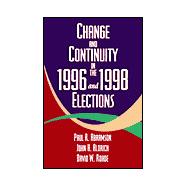Employing the National Election Studies survey from the University of Michigan and other reputable polls, the authors analyze:
-- Why voters rejected the Republican scandal agenda
-- What issues were uppermost on voters' minds
-- Which voting groups voted for whom ... and why, and
-- How the 1998 election bodes for the year 2000 presidential election and beyond.
Change and Continuity in the 1996 and 1998 Elections also includes complete analysis of the 1996 elections that brought Clinton to the White House for a second term.








